Two CARLI Preservation Events Summaries: Choosing and Constructing Protective Enclosures for Library Materials Workshop and Conservation Lab Open Houses at the Abraham Lincoln Presidential Library and the Illinois State Military Museum
Tonia Grafakos, Northwestern University
Susan Howell, Southern Illinois University Carbondale
Bonnie Parr, Abraham Lincoln Presidential Library and Museum
The CARLI Preservation Committee had a busy spring hosting two preservation events: Choosing and Constructing Protective Enclosures for Library Materials workshop held at the Abraham Lincoln Presidential Library and Museum on May 8, 2019 and Conservation Lab Open Houses at the Abraham Lincoln Presidential Library and the Illinois State Military Museum on June 7, 2019.
Choosing and Constructing Protective Enclosures for Library Materials Workshop
Commercially Available Enclosures
Participants from around the state began their day at the Choosing and Constructing Protective Enclosures for Library Materials workshop learning about commercially available enclosures. Tonia Grafakos from Northwestern University shared many different types of housings which were passed around to participants and their attributes were discussed.
Housing preferences are different for each institution and can be limited by institutional-specific restrictions such as funding for staff or supplies and types of shelving or storage spaces. When deciding on an enclosure for collections material, two questions need to be asked. Namely, where is it going to be stored and how is the material going to be used? Solutions can differ for items that are heavily used or part of special collections or if they are in off-site storage facility versus on site.
When choosing a product it is important to carefully read the product description. Manufacturers often use the term archival to describe their products. It is best to investigate how the manufacturer defines archival. Depending on the needs of a particular collection you may be looking for different characteristics. Also keep in mind that many commercially available housings can be customized to fit a collection’s needs thus enabling institutions to house a variety of material using standard boxes.
In this workshop, part of the discussion in choosing appropriate housings centered on decision-making. Housing decisions should incorporate patron usage, collection needs, and institutional priorities.
Hands-On: Making Enclosures
The purpose of the hands-on component of the workshop was to provide a skill participants could take back to their institutions and implement.
Bonnie Parr from the Abraham Lincoln Presidential Library and Museum taught a hands-on session for creating wrappers for thin books. This wrapper was a one-piece construction using 20 point (.020) heavy folder stock. Susan Howell and Jason Blohm from Southern Illinois University Carbondale taught a hands-on session for creating e-flute clamshell boxes.
The sessions complemented one another. Both activities used a similar system of measuring the object and marking the enclosure material. The wrapper session used the metric system of measurement and the clamshell session used U.S. customary system. Before the workshop, folder stock and e-flute were cut to the size of the sample book for time efficiency. Both enclosures were one-piece constructions. Techniques were demonstrated, and then participants worked through the steps one at a time.
Handouts were provided with detailed step-by-step instructions and worksheets for calculations. The handouts could enable participants to make wrappers and enclosures after the event at their own institutions. Precut board was also provided for participants to take home with them for further practice.
Upon completion of the workshop, many participants expressed that this was something they would take back to their institutions and either do themselves or teach others to make enclosures. Since the workshop, we at Southern Illinois University Carbondale have made several of these wrappers and enclosures.
Presentations and handouts for the program are available on the CARLI Preservation Resources website under “Past Webinars and Events”.
Conservation Lab Open Houses at the Abraham Lincoln Presidential Library and Museum and the Illinois State Military Museum
On June 7, 2019, participants from around the state attending the Conservation Lab Open Houses at the Abraham Lincoln Presidential Library and the Illinois State Military Museum started their day at the Abraham Lincoln Presidential Library. Bonnie Parr, Conservator, and Carla Smith, Registrar, showed a sampling of objects from the library’s collection – a violin made by a Civil War soldier, a jersey autographed by team members of the Chicago Blackhawks, a pair of leather boots worn by Dan Walker as he walked the state of Illinois during his 1971 gubernatorial campaign, a child’s hand-painted porcelain tea set, and an eighteenth-century brick.
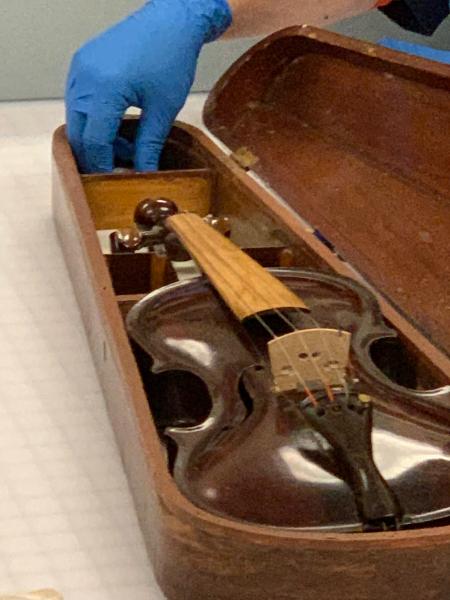
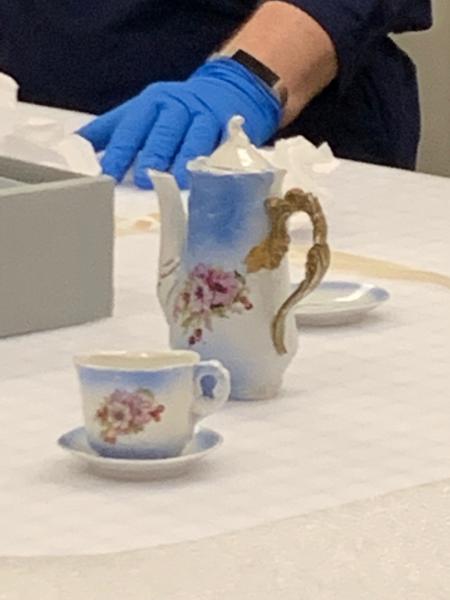
Bonnie and Carla talked about the decisions made in housing these different types of items including: factors considered in properly protecting and supporting them, their enclosures, materials used for padding, and even thoughts on how to improve their current storage enclosures. Attendees were given tours of the climate-controlled stacks where the artifact collection is stored and the library’s conservation lab.
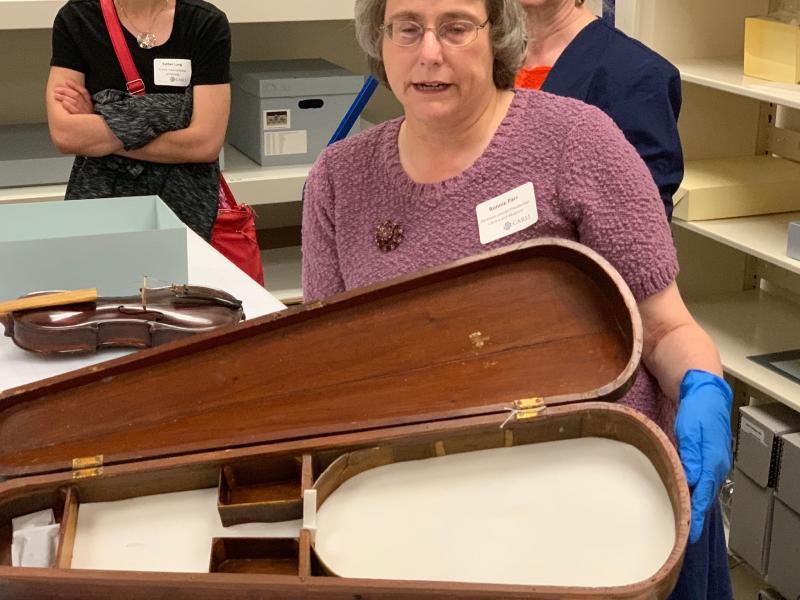
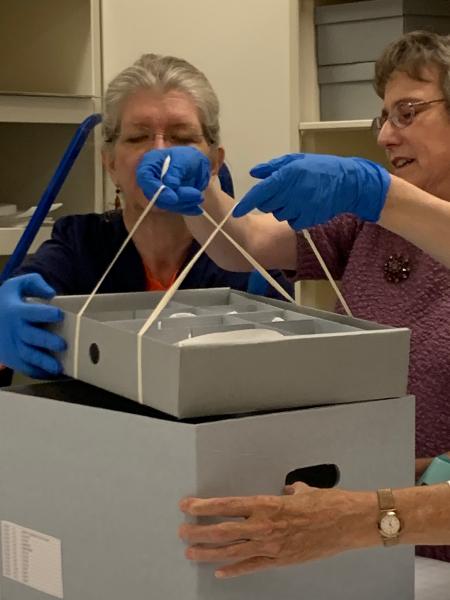
After lunch, the group drove to Camp Lincoln, an Illinois National Guard Base, to visit the conservation lab of the Illinois State Military Museum. Bill Lear, Museum Curator and Conservator, his staff, and volunteers gave a tour of the conservation lab, a climate-controlled building built within a former Sherman Tank barn. Bill talked about conservation treatments for flags in the museum’s collection and how their conservation program and storage facility developed to properly care for the flags and other military artifacts.
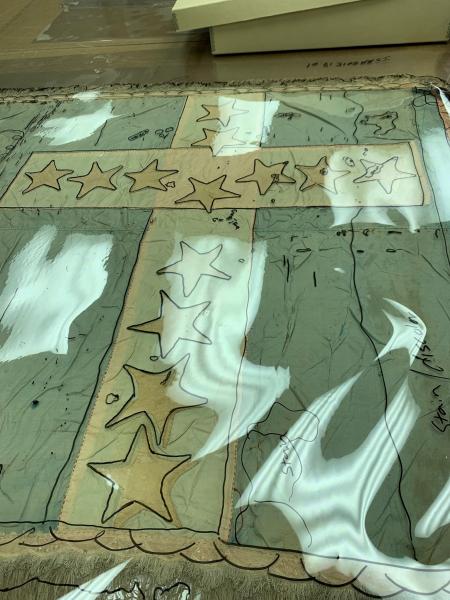
Of the artifacts on display for this tour, participant were shown a Confederate flag (of the First Tennessee Artisan Rangers) in the process of conservation treatment, a circa 1885-1905 helmet with feathers (as an example of the difficulties in determining appropriate storage for an item composed of vastly different materials), and an 1895 uniform frock coat worn by John Kelly, a Medal of Honor recipient (an artifact with a compelling story).
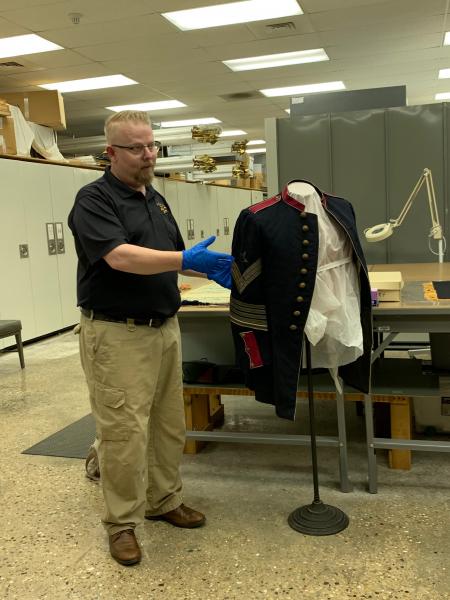
As Bill and his staff told the stories about these pieces and others in the collection, participants were shown how flags are stored flat in custom-built oversize drawers, how uniforms from several eras are hung on padded hangers or covered with cotton dust covers, and how medals, pins, patches, and other small pieces are organized in trays or nested in Ethafoam cut-outs in drawers.
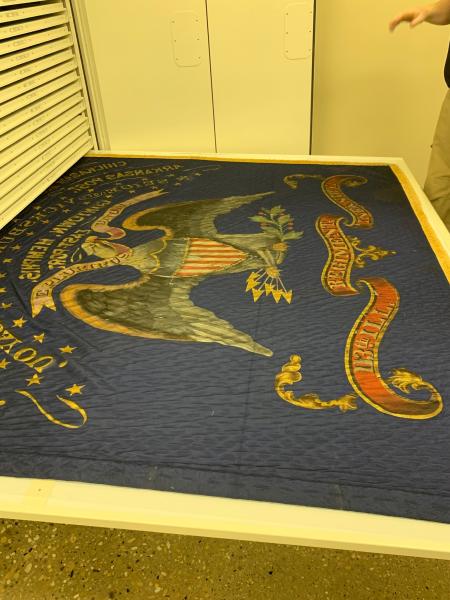
Concluding the Open House event, Bill took the group to the Military Museum (outside of the National Guard Base) for a personalized tour of the museum and its exhibits.
These two events were in support of the CARLI Preservation Committee's year-long project Beyond the Book: Preserving your Non-Book Collections.

